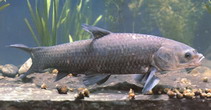http://www.fishbase.org/Summary/speciesSummary.php?genusname=Mylopharyngodon&speciesname=piceus ---> http://192.134.151.83/Summary/speciesSummary.php?genusname=Mylopharyngodon&speciesname=piceus
http://192.134.151.83/Summary/speciesSummary.php?genusname=Mylopharyngodon&speciesname=piceus ---> https://fishbase.mnhn.fr/Summary/speciesSummary.php?genusname=Mylopharyngodon&speciesname=piceus
https://fishbase.mnhn.fr/Summary/speciesSummary.php?genusname=Mylopharyngodon&speciesname=piceus ---> https://fishbase.mnhn.fr/summary/Mylopharyngodon-piceus.html
Mylopharyngodon piceus, Black carp : fisheries, aquaculture

You can
sponsor
this page
Common name (e.g. trout)
Genus + Species (e.g. Gadus morhua)
-

-
About this page
-
Languages
-
User feedbacks
-
Citation
-
Uploads
-
Related species
-


 Black carp
Upload your
photos
and
videos
Black carp
Upload your
photos
and
videos
Pictures
|
Google image
 Mylopharyngodon piceus
Mylopharyngodon piceus
Picture by
CAFS
Teleostei (teleosts) >
Cypriniformes
(Carps) >
Xenocyprididae
(East Asian minnows)
Etymology:
Mylopharyngodon:
Greek, mylo = mill + Greek, pharynx = throat + Greek, odous = teeth (Ref.
45335
)
.
More on author:
Richardson
.
Environment: milieu / climate zone / depth range / distribution range
Ecology
Freshwater; brackish; demersal; pH range: 7.5 - 8.5; potamodromous (Ref.
51243
); depth range 5 - 30 m (Ref.
6898
). Subtropical; 0°C - 40°C (Ref.
55930
); 53°N - 15°N, 100°E - 140°E (Ref.
55930
)
Asia: Amur river basin to southern China (Ref.
55930
). Reported from Vietnam (Ref.
44416
). Persists only in Europe by stocking or accidental releases; native stocks in Russia have declined sharply (Ref.
59043
). Several countries reported adverse ecological impact after introduction.
Length at first maturity / Size / Weight / Age
Maturity: L
m
91.5
, range 100 - ? cm
Max length : 180 cm TL male/unsexed; (Ref.
40637
); common length : 12.2 cm SL male/unsexed; (Ref.
35840
); max. published weight: 35.0 kg (Ref.
56557
); max. reported age: 13 years (Ref.
55930
)
Dorsal
spines
(total): 0;
Dorsal
soft rays
(total): 7-9;
Anal
spines
: 0;
Anal
soft rays
: 8 - 10. Anatomy of the pharyngeal apparatus is the main distinguishing characteristic; throat teeth typically form a single row of 4-5 large molariform teeth on each of the two arches, with formula typically 1,4 - 4,1.
Adults inhabit large lowland rivers and lakes, preferably with clear water and high oxygen concentrations. Larvae feed on zooplankton, then on ostracods and aquatic insects. At about 120 mm SL, juveniles start to prey on small snails and clams while larger juveniles and adults feed almost entirely on molluscs. Undertake upriver migration and spawns in open waters. Deposit pelagic or semipelagic eggs which hatch while drifting downstream. Larvae settle into floodplain lakes and channels with little or no current (Ref.
59043
). Maximum age probably exceeds 15 years; the figure of 20 years is not supported by data (Ref.
55930
).
Prewspawning adults migrate upstream in spring - early summer; spawning takes place in turbulent waters; eggs are pelagic and drift downstream and larvae enter nursery areas such as flood plains or backwater habitats; main river channel is used as feeding and wintering area by subadults and adults.
Nico, L.G., J.D. Williams and H.L. Jelks
, 2005. Black carp: biological synopsis and risk assessment of an introduced fish. American Fisheries Society, Bethesda, Maryland, USA. 337 p. (Ref.
55930
)
IUCN Red List Status (Ref.
130435
)
Least Concern (LC)
; Date assessed:
02 April 2020
CITES
Not Evaluated
Not Evaluated
Threat to humans
Potential pest (Ref.
74657
)
Human uses
Fisheries: highly commercial; aquaculture: commercial
FAO - Aquaculture:
production
; Fisheries:
landings
; Publication:
search
|
FishSource
|
More information
Countries
FAO areas
Ecosystems
Occurrences
Introductions
Stocks
Ecology
Diet
Food items
Food consumption
Ration
Common names
Synonyms
Metabolism
Predators
Ecotoxicology
Reproduction
Maturity
Spawning
Spawning aggregation
Fecundity
Eggs
Egg development
Age/Size
Growth
Length-weight
Length-length
Length-frequencies
Morphometrics
Morphology
Larvae
Larval dynamics
Recruitment
Abundance
BRUVS
References
Aquaculture
Aquaculture profile
Strains
Genetics
Electrophoreses
Heritability
Diseases
Processing
Nutrients
Mass conversion
Collaborators
Pictures
Stamps, Coins Misc.
Sounds
Ciguatera
Speed
Swim. type
Gill area
Otoliths
Brains
Vision
Tools
Bio-Quiz
|
E-book
|
Field guide
|
Length-frequency wizard
|
Life-history tool
|
Point map
|
Classification Tree
|
Catch-MSY
|
Special reports
Check for Aquarium maintenance
|
Check for Species Fact Sheets
|
Check for Aquaculture Fact Sheets
Download XML
Summary page
|
Point data
|
Common names
|
Photos
Internet sources
AFORO (otoliths) |
Alien/Invasive Species database
|
Aquatic Commons
|
BHL
|
Cloffa
|
BOLDSystems
|
Websites from users
|
Check FishWatcher
|
CISTI
|
Catalog of Fishes
:
genus
,
species
|
DiscoverLife
|
ECOTOX
| FAO - Aquaculture:
production
; Fisheries:
landings
; Publication:
search
|
Faunafri
| Fishipedia |
Fishtrace
| GenBank:
genome
,
nucleotide
|
GloBI
|
Google Books
|
Google Scholar
|
Google
|
IGFA World Record
|
MitoFish
|
National databases
|
Otolith Atlas of Taiwan Fishes
|
PubMed
| Reef Life Survey | Socotra Atlas |
Tree of Life
| Wikipedia:
Go
,
Search
|
World Records Freshwater Fishing
|
Zoological Record
Estimates based on models
Phylogenetic diversity index (Ref.
82804
): PD
50
= 1.0000 [Uniqueness, from 0.5 = low to 2.0 = high].
Bayesian length-weight: a=0.00912 (0.00777 - 0.01070), b=3.09 (3.05 - 3.13), in cm total length, based on LWR estimates for this species (Ref.
93245
).
Trophic level (Ref.
69278
): 3.2 ±0.44 se; based on food items.
Resilience (Ref.
120179
): Low, minimum population doubling time 4.5 - 14 years (K=0.08-0.09; tm=3-9; tmax >13; Fec=1,000,000).
Fishing Vulnerability (Ref.
59153
): Very high vulnerability (80 of 100).
Price category (Ref.
80766
):
Unknown
.
Nutrients (Ref.
124155
): Calcium = 73 [39, 113] mg/100g; Iron = 1.13 [0.72, 1.80] mg/100g; Protein = 18.9 [18.0, 19.8] %; Omega3 = 0.335 [0.177, 0.670] g/100g; Selenium = 31.1 [15.8, 64.3] μg/100g; VitaminA = 7.37 [2.88, 20.58] μg/100g; Zinc = 0.713 [0.531, 0.987] mg/100g (wet weight);
Back to Search
Random Species
Back to Top
Accessed through:
Not available
FishBase mirror site :
localhost
Page last modified by :
mrius-barile
- 20 July 2016
Fatal error
: Uncaught ArgumentCountError: Too few arguments to function checkEcotox(), 1 passed in /var/www/html/summary/speciessummary.php on line 2304 and exactly 3 expected in /var/www/html/includes/speciessummary.lib.php:2579 Stack trace: #0 /var/www/html/summary/speciessummary.php(2304): checkEcotox() #1 {main} thrown in
/var/www/html/includes/speciessummary.lib.php
on line
2579
|